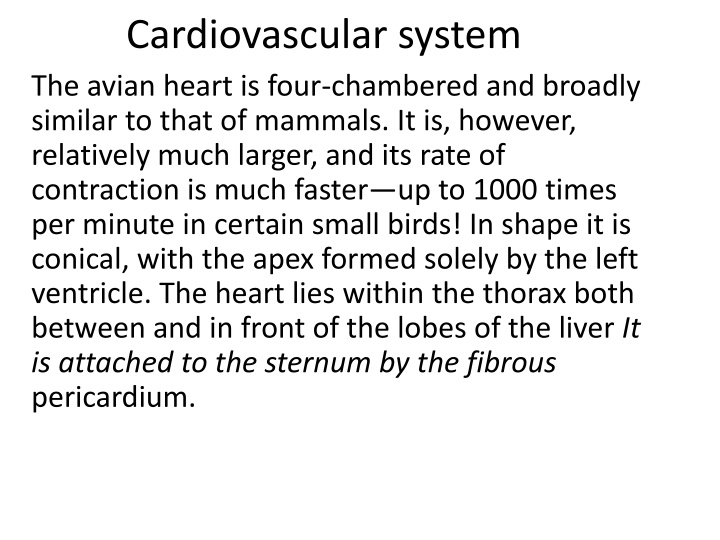
Fascinating Insights into the Avian Cardiovascular System
Explore the unique characteristics of the avian heart, including its four-chambered structure, rapid rate of contraction, and distinct blood circulation pathways. Learn about the specialized valves, blood vessels, and anatomical features that contribute to the efficient functioning of the avian circulatory system.
Download Presentation

Please find below an Image/Link to download the presentation.
The content on the website is provided AS IS for your information and personal use only. It may not be sold, licensed, or shared on other websites without obtaining consent from the author. If you encounter any issues during the download, it is possible that the publisher has removed the file from their server.
You are allowed to download the files provided on this website for personal or commercial use, subject to the condition that they are used lawfully. All files are the property of their respective owners.
The content on the website is provided AS IS for your information and personal use only. It may not be sold, licensed, or shared on other websites without obtaining consent from the author.
E N D
Presentation Transcript
Cardiovascular system The avian heart is four-chambered and broadly similar to that of mammals. It is, however, relatively much larger, and its rate of contraction is much faster up to 1000 times per minute in certain small birds! In shape it is conical, with the apex formed solely by the left ventricle. The heart lies within the thorax both between and in front of the lobes of the liver It is attached to the sternum by the fibrous pericardium.
The right atrium receives paired cranial venae cavae and a single caudal atrioventricular valve is formed by a single muscular flap without chordae tendineae. The pulmonary veins combine to form a single trunk before entering the left atrium at an entrance provided with a valve capable of preventing reflux. vena cava. The right
The left atrioventricular valve has three cusps attached to chordae tendineae. The thick walled left ventricle is conical. Internally muscular bars give the cross section a rosette-like form. Cardiac puncture, performed for blood sampling, is dangerous in small birds .
Carotids deliver blood to the head (& brain).Brachials take blood to the wings. Pectorals deliver blood to the flight muscles (pectoralis). The systemic arch is also called the aorta & delivers blood to all areas of the body except the lungs. The pulmonary arteries deliver blood to the lungs. The celiac (or coeliac) is the first major branch of the descending aorta & delivers blood to organs & tissues in the upper abdominal area. Renal arteries deliver blood to the kidneys. Femorals deliver blood to the legs & the caudal artery takes blood to the tail. The posterior mesenteric delivers blood to many organs & tissues in the lower abdominal area.
The jugular anastomosis allows blood to flow from right to left side when the birds head is turned & one of the jugulars constricted.The jugular veins drain the head and neck. The brachial veins drain the wings. The pectoral veins drain the pectoral muscles and anterior thorax. The superior vena cavae (or precavae) drain the anterior regions of the body. The inferior vena cava (or postcava) drains the posterior portion of the body. The hepatic vein drains the liver. The hepatic portal vein drains the digestive system. The coccygeomesenteric vein drains the posterior digestive system & empties in the hepatic portal vein. The femoral veins drain the legs. The sciatic veins drain the hip or thigh regions. The renal & renal portal veins drain the kidneys.
Electrical activity in the avian heart during a cardiac cycle -- The P wave begins after sinus node depolarization near the top of the right atrium, and the impulse spreads through the atria toward the apex of the heart going caudally (down) and to the left . The impulse then travels through the AV (atrioventricular) transmission system to the ventricular myocardium (or heart muscle). Initial activation of the endocardium surrounding the apex of the left ventriclecauses a small, upright deflection, or R wave, in the ECG). Depolarization of the remainder of the ventricular wall during this time is not detected in the ECG because extensive and complete penetration of the walls by Purkinje fibers resulted in a single burst of mutually canceling electrical activity. Next, a large RS wave, or simply S wave, results from rapid, depolarization of the ventricle. Surface electrode placement = RA indicates right axilla, or right wing .
Avian hearts also tend to pump more blood per unit time than mammalian hearts. In other words, cardiac output (amount of blood pumped per minute) for birds is typically greater than that for mammals of the same body mass. Cardiac output is influenced by both heart rate (beats per minute) and stroke volume (blood pumped with each beat). 'Active' birds increase cardiac output primarily by increasing heart rate.
